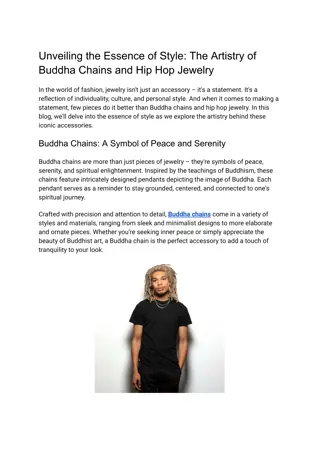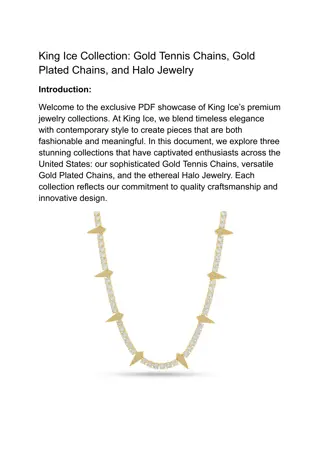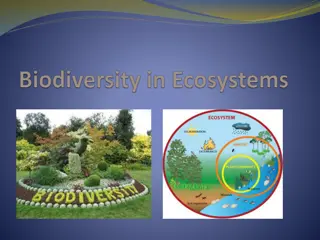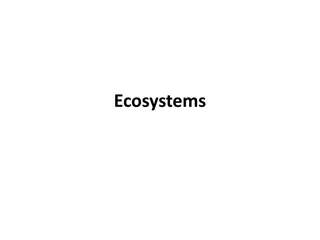Understanding Food Chains and Ecosystems in Nature
Explore the interdependence of living organisms in their environment through food chains, trophic levels, and the roles of producers, consumers, and decomposers. Learn how energy flows through ecosystems, the classification of animals based on feeding styles, and the vital role of decomposers in recycling nutrients. Discover how humans can utilize decomposers to manage waste effectively and promote sustainability.
Download Presentation

Please find below an Image/Link to download the presentation.
The content on the website is provided AS IS for your information and personal use only. It may not be sold, licensed, or shared on other websites without obtaining consent from the author. Download presentation by click this link. If you encounter any issues during the download, it is possible that the publisher has removed the file from their server.
E N D
Presentation Transcript
Videos: https://www.youtube.com/watch?v=eGG7hyx_HlA ecosystem https://www.youtube.com/watch?v=T5XhbhqOL_c trophic levels https://www.youtube.com/watch?v=JJmSz7PGfcA Decomposers
What is a food chain? What is a food chain? It is a series in which food and energy move from one organism to another.
The three categories of the food chain are Producers Consumers Decomposers They are all dependent on each other.
Producers Producers Producers get their energy from the sun. They make their own food through a process called photosynthesis. Plants that make their own food are usually green in color. The green color tells us that they have chlorophyll.
Consumers Consumers Consumers are organisms that cannot make their own food, they eat the food that producers make or they eat other organisms. There are three types of Consumers: Carnivores Herbivores Omnivores. It is all about what you eat!
Animals are classified according to their feeding styles feeding styles into: Herbivore: an animal that only eats plants. Carnivore: an animal that only eats other animal. Omnivore: an animal that eats both plants and animals. Food chain: a diagram that shows the way some organisms in a habitat are linked to each other through feeding. The arrows represent the flow of energy, the producers absorb light energy and produce biomass (the energy in living organisms).
Decomposers Decomposers Decomposers are very tiny animals (microorganisms) that eat waste and the remains of dead plants and animals. They break down the waste and remains into simple chemicals and nutrients. These chemicals can be used again by other living things. Examples: Mushrooms, Bacteria, Worms, Bugs and snails.
Making use of the decomposers People need a lot of food and produce a lot of bodily waste. We use decomposers to help us solve both of these problems. Making compost: we use decomposers to break down our kitchen and garden waste. In the right conditions, bacteria and fungi break this down into a brown, soil-like substance called compost. Adding compost to your soil puts back nutrients, so your plants grow bigger and better. Treating sewage: microorganisms decompose the waste and break it down so it does not damage the environment.
Scavengers Scavengers Another type of consumer is a scavenger. Scavengers eat the bodies of other dead animals. Vultures are large birds that are scavengers.
In a food chain, organisms are classified In a food chain, organisms are classified according to their role according to their role into: into: Producer: an organism that produces food at the beginning of a food chain. Consumer: an animal that eats plants, other animals or both. Primary consumer: an animal that eats plants (this maybe a herbivore or an omnivore) Secondary consumer: an animal that eats primary consumers (this maybe a carnivore or an omnivore) Tertiary consumer: an animal that eats secondary consumers (this maybe a carnivore or an omnivore) Quaternary consumer: an animal that eats tertiary consumers. Top carnivore: an animal at the end of the food chain.
Example 1 Example 1 : The diagram shows part of a : The diagram shows part of a desert food web: desert food web:
1. Circle the producer in the food web. 2. Name all the consumers : insects , rodents , lizards ,spiders ,scorpions , lizards ,snakes ,foxes 3. Underline all the primary consumers. 4. Double underline all the secondary consumers. 5. What type of consumer is a fennec fox? circle the correct answer Tertiary consumer Secondary consumer Both of them 6. Some lizard species are herbivores, others are carnivores. Write two food chains, one for each type of lizard. Grass shrubs or trees lizards foxes ( herbivore ) Grass shrubs or trees insects lizards foxes (carnivore )
Example 2 Example 2 : : The diagram shows a food web in areas of grassland. The diagram shows a food web in areas of grassland. a. Classify the organisms in the table below. Producers herbivores Rabbit Mouse Snail Caterpillar carnivores Grasses Dandelions Fox Owl Blackbird
b. Write three food chains from this food web. Grasses rabbit fox Dandelions caterpillar owl grasses mouse fox c. One year the snail population increased in the grassland area. How could an increase in the number of snails cause the caterpillar population to change? The caterpillar population will decrease because both of them feed on dandelions
Trophic levels : The position of a living thing in a food chain is called its trophic level. The producers 1st trophic level Primary consumers ( herbivores ) 2nd trophic level All the animals at higher trophic levels are carnivores.
Trophic levels : Biomass decreases with each trophic level. There is always more biomass (stored energy) in lower trophic levels than in higher ones. Biomass: the amount of material in a plant (or any living creature). Plants produce biomass through photosynthesis.
In any habitat, the producers absorb light energy and produce biomass (the energy in living organisms). When consumers eat the biomass, only 10% of the energy will be stored in the second level and the rest of the energy will be wasted or consumed for life processes.
Energy is lost at each level in a food chain or a food web as shown in the figure below: (observe the change in size of the arrows)
Question : Complete the diagram below by putting each organism in each Question : Complete the diagram below by putting each organism in each lizard s food chain in the correct trophic level. lizard s food chain in the correct trophic level. Fennec foxes Fennec foxes Snakes
Question : The diagram below shows a pyramid of Question : The diagram below shows a pyramid of biomass biomass . Match each of the following organisms to the correct trophic level : a. Insect / 2 b. frog / 3 c. snake / 4 d. Grass / 1
Example 1 Example 1 :The diagram below shows the energy transfer in a :The diagram below shows the energy transfer in a food chain : food chain : Calculate how much energy the fox uses to build new tissues . Calculate how much energy the fox uses to build new tissues . 1kJ
Example 2: The diagram shows an energy pyramid which represents the amount of energy available at each trophic level in this food chain . 1. Name the producer: Grass 2. Name the animal in the 3rd trophic level : snake 10 100 3. Name the top carnivore : eagle 4. Calculate the amount of energy that will be transferred in each level ? on the diagram 1000
Question :Use the pyramid to answer the Question :Use the pyramid to answer the following questions. following questions. 1. Which level contains the organisms with the highest amount of energy? A 2. Top predators are found in level . D 3. Which level contains herbivores? B 4. How does the amount of energy changes as you move from level A to level D? it will Decrease 5. In a community of grass, rabbit, fox and eagle, which organism will fill level C? fox
Question :The diagram below shows how minerals are recycled . 1. Name the process represented by arrow A Decomposition 2. What type of organism carries out process A ? Decomposers 3. Name two examples of this type of organism fungi and bacteria 4. Explain why process A is vital to life in earth they add minerals to the soil
A decomposer is an organism that: a)eats plants only. b)breaks down dead things. c)eats meat only.
Which series correctly describes how energy is passed among the four organisms? a) consumer, consumer, decomposer, producer b) decomposer, consumer, consumer, producer c) producer, consumer, consumer, decomposer d) consumer, decomposer, producer, consumer
In the environment, how is the role of a decomposer different from that of a scavenger? a)A decomposer uses the sun's energy to produce its own food while scavengers do not use the sun's energy. b)A decomposer breaks down dead organisms and feces into chemicals while a scavenger breaks down dead organisms without producing chemicals for soil. c)A decomposer eats living plants and animals to get energy while a scavenger obtains its energy from eating plants and animals. d)Both a decomposer and a scavenger are microscopic and has a small role in the environment.
Kahoot games https://create.kahoot.it/details/23ece7db-e0cf-4964-8923- 542d21472198 https://create.kahoot.it/details/6938dc2c-b084-41a0-95b9- 15aff8e6fb83























